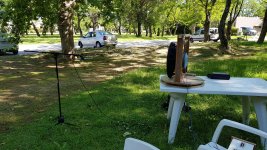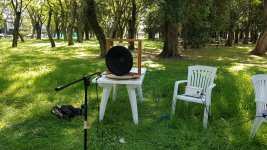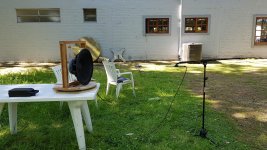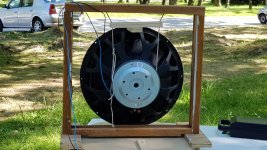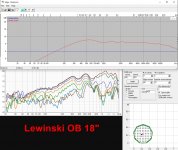Dual channel outside files are priceless, just remember to save 🙂
Mic is placed what ever you want the reference axis to be
What would dual channel be?
- What REW gating settings should I use? I'm used to measuring indoors and gating to avoid reflections, which I shouldn't have much tomorrow.
How important is windowing when measuring outside? Is it OK to leave REW to set windowing automatically? Meaning it will allow 500ms right side and 125ms left side.
Or should I reduce windowing? FDW at longer values, like 30 (or more)?
@LewinskiH01,
How does your OB speaker sound to your ears from where you usually listens from? Is it better than the boxed systems you have?
How does it sound, if you place the OB speaker in a free corner of your room, equidistant from the walls, OB speaker placed at 45 degrees?
How does it sound if you turn the speaker the other way and face to the corner?
All, from your normal listening place. Thank you.
How does your OB speaker sound to your ears from where you usually listens from? Is it better than the boxed systems you have?
How does it sound, if you place the OB speaker in a free corner of your room, equidistant from the walls, OB speaker placed at 45 degrees?
How does it sound if you turn the speaker the other way and face to the corner?
All, from your normal listening place. Thank you.
Gating is always done after measurements, when analyzing. JUST REMEMBER TO SAVE MEASUREMENTS!
Naturally, when setting up the measurement system, make test measurements and check impulse response. Try to minimize reflection energy (amplitude) maximize reflection-free time interval. That is by moving speaker, mic, measuring axis direction, etc.
Don't measure too far away, 1,5 -2m at most! if possible, tilt the speaker/turntable so that you can put the mic at ground level or near it.
ErinsAudioCorner | Page 7 | Audio Science Review (ASR) Forum
Naturally, when setting up the measurement system, make test measurements and check impulse response. Try to minimize reflection energy (amplitude) maximize reflection-free time interval. That is by moving speaker, mic, measuring axis direction, etc.
Don't measure too far away, 1,5 -2m at most! if possible, tilt the speaker/turntable so that you can put the mic at ground level or near it.
ErinsAudioCorner | Page 7 | Audio Science Review (ASR) Forum
Last edited:
Why is that? With groundplane typical floor bounce diappears and it is the worst and first reflections outdoors. Typically around 300-800Hz.
Naturally for simulation data, changing on-axis line and maintaining distance gets difficult. Easier to keep speaker vertical and change mic height on the stand. But then floor bounce moves...
Naturally for simulation data, changing on-axis line and maintaining distance gets difficult. Easier to keep speaker vertical and change mic height on the stand. But then floor bounce moves...
A box speaker is easy to put sideways on a stand, then one just moves the mic sideways to change axis "height" - and bounce remains same. Horizontal off-axis gets difficult...
Tomorrow I plan to take a trip to where I can measure outside. Would like to get input to insure my measurements turn out useful. The goal is to have measurements to help make informed decisions about xo points, and suitability of these drivers.
Cause of this im guessing he is measuring single drivers not whole speaker. And im thinking if doing such measuring it should be done in chosen axis.
@LewinskiH01,
How does your OB speaker sound to your ears from where you usually listens from? Is it better than the boxed systems you have?
How does it sound, if you place the OB speaker in a free corner of your room, equidistant from the walls, OB speaker placed at 45 degrees?
How does it sound if you turn the speaker the other way and face to the corner?
All, from your normal listening place. Thank you.
Please note I have built just one OB, therefore hearing to one speaker in mono, and I sit where I usually do but toed-in the chair to be facing on axis with speaker (same for the speaker toe-in). So my comparisons have limitations, including the time it takes to switch from one setup to another (which usually doesn't happen the same day).
Having put the disclaimer, I like it quite a bit! I really like the bass. And the open back tweeter makes for an unusual sound at certain points in the room where I'm used not to hear highs, yet there you have them now. Nice.
Right now I'm redoing the room, contractors in, system disassembled, impossible to try the things you ask. But FWIW the location I had my speaker in was close to 45 degree diagonal.
Gating is always done after measurements, when analyzing. JUST REMEMBER TO SAVE MEASUREMENTS!
Naturally, when setting up the measurement system, make test measurements and check impulse response. Try to minimize reflection energy (amplitude) maximize reflection-free time interval. That is by moving speaker, mic, measuring axis direction, etc.
Don't measure too far away, 1,5 -2m at most! if possible, tilt the speaker/turntable so that you can put the mic at ground level or near it.
ErinsAudioCorner | Page 7 | Audio Science Review (ASR) Forum
Too bad I didn't see this earlier. I already ran the measurements and didn't do ground plane. Will read thru over the week to learn and understand better. It's pretty difficult to tilt a swinging speaker, though. Especially an 18"!!!😱
I was able to run outside measurements of my new 18" nude on a swing, 0 to 180°. It was a windy day and the 18" moved with the wind given the swing and large surface, despite the weight. Ran out of time to do the other drivers.
The space was quite open: about 70m to any flat surfaces on three sides and 10m to a wall (extender power cable being the limiting factor). At 0° the speaker axis was parallel to that wall, so hopefully not significant reflections. The woofer center was about 90cm to 1m off the floor, and so was the mic. The mic was 1.1m away from the dustcap. Measurements every 15°, REW set to automatic windowing width. Graphs are smoothed to 1/12 for clarity. Pictures of the setup attached.
Here are the front measurements, 0 to 90°:
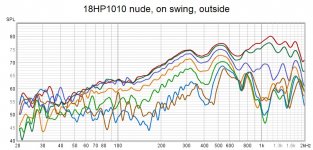
The back half:
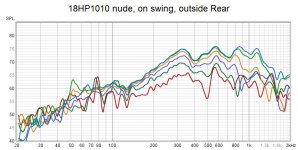
And front vs back (limiting number for ease of interpretation):
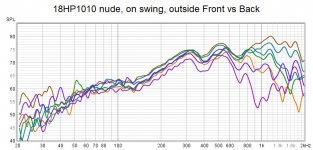
What do you think?
Here are my takeaways, shared to get feedback in case I'm misunderstanding:
Looking forward for your insights/opinions!
The space was quite open: about 70m to any flat surfaces on three sides and 10m to a wall (extender power cable being the limiting factor). At 0° the speaker axis was parallel to that wall, so hopefully not significant reflections. The woofer center was about 90cm to 1m off the floor, and so was the mic. The mic was 1.1m away from the dustcap. Measurements every 15°, REW set to automatic windowing width. Graphs are smoothed to 1/12 for clarity. Pictures of the setup attached.
Here are the front measurements, 0 to 90°:

The back half:

And front vs back (limiting number for ease of interpretation):

What do you think?
Here are my takeaways, shared to get feedback in case I'm misunderstanding:
- Front vs back response are pretty similar, which is what I intended when choosing this driver.
- The driver seems usable from 50Hz, maybe even lower, but there are 3dB between response at 50 and 70Hz, so might be better to cross at 70Hz.
- How high should I cross the top? I use Acourate, that effectively lowers everything above the target curve I could go up to 650Hz (71dB at 15°) and that would be 11dB over the response at 70Hz (60dB at 15°). People usually cross 18"s lower, though, so maybe 300 or 400Hz would be better. Too bad I didn't get to measure the midrange today
Looking forward for your insights/opinions!
Attachments
Last edited:
You have to listen that lower point how you like it, cause there will be steep cut on power response down that point, i would start 60-300hz with that faital.
Please note I have built just one OB, therefore hearing to one speaker in mono, and I sit where I usually do but toed-in the chair to be facing on axis with speaker (same for the speaker toe-in). So my comparisons have limitations, including the time it takes to switch from one setup to another (which usually doesn't happen the same day).
Having put the disclaimer, I like it quite a bit! I really like the bass. And the open back tweeter makes for an unusual sound at certain points in the room where I'm used not to hear highs, yet there you have them now. Nice.
Right now I'm redoing the room, contractors in, system disassembled, impossible to try the things you ask. But FWIW the location I had my speaker in was close to 45 degree diagonal.
Thanks. I am going to watch your thread. I am interested in what you ears hear, rather what any instruments measure. 🙂 Once your room is done, see (or hear) how it sounds with the speaker facing the corner and vice versa.
I have a pair of Sony box speakers, made some years ago, that can be called bookshelf. They are 4-way speakers -- woofer, mid and the tweeter facing forward and also with 2 more mid drivers fixed at 45 degrees to the sides in the horizontal plane. All told, 3 mid drivers. They are placed 3m between them on a shelf, back flush to the wall. There's nothing on the sides and above the speakers. I am sitting about 2.5m from the line of the speakers. The tweeter is in line with my ears, the rest are below. I hear the stereo sound everywhere, but mostly more than a meter above my head, in front of me, but sort of further away from the plane of the wall. With all the earlier speakers, I heard the sound in front of me, ear level. If I close my eyes and listen, musical instruments are played in different places, the vocalist is singing, all above my head, before me further than the distance to the wall. This is the first time, I had heard stereo sound this way, above and away. Even though, I feel like building an omnidirectional system, I'll never get rid of these speakers.
I would like to know how you hear your OB speaker(s), when you have time.
Last edited:
Turntable and table were too close to the driver, looks like they are causing the dip at 400Hz. Ground bounce is around 150Hz, estimated distances from pic. Freq-dependent windowing per 15 cycles seems to be default in REW and it looks ok, but for Vituixcad etc. sims I don't know...
Wind noise around 55-60dB but low end is pretty much predictable.
Here is Edge sim compared to your measurements
When you consider xo, remember that preferably one octave above xo shoud be smooth and with constant directivity! So xo in 400-600Hz range? And yes, you'll need lots of eq in low end!
Wind noise around 55-60dB but low end is pretty much predictable.
Here is Edge sim compared to your measurements
When you consider xo, remember that preferably one octave above xo shoud be smooth and with constant directivity! So xo in 400-600Hz range? And yes, you'll need lots of eq in low end!
Attachments
Last edited:
I really like the bass.
Me too. I often use my OB subs with my monopole mains (high passed)
I have and IB sub in the wall in the corner too.
I think, and it feels, like it could be due to room pressurisation, but OB is more comfortable on my ears and sounds less resonant.
I was able to run outside measurements of my new 18" nude on a swing, 0 to 180°. It was a windy day and the 18" moved with the wind given the swing and large surface, despite the weight. ....
As you are not going to use your OB system outside, I can't see the reasoning behind the tests outside.
All drivers push sound waves both way, front and back. From the front, the sound angle depends on the cone's smaller angle, whereas from the back, the open angle is larger (360 - the cone angle), so the sound waves practically go out everywhere. They hit the wall behind, the furniture near it, the floor and whatever that's nearby. Some would absorb the sound and some would reflect it. And, you'd hear the mishmash of all that.
So, in a way, if you are going to have a real OB system, you'd have to have a room without anything near and behind the OB system to get the best out of it (according to your ears). You'd have to have one wall in the room without any furniture, practically. Depending on the way you'd like the system to sound, you'd either have to dampen the walls behind the system, or make then shiny to fully reflect. In one is living in a flat, it might be pretty hard to have a room with a free of furniture wall. 🙂 Also, you cannot place the speakers too near the wall. I've seen a friend with an OB system, moving them here and there, for it was so hard to find a better place in his apartment living room. It always appeared to be wrong, after a while.
In a boxed speaker, you are carrying the "room" inside that box, so they can be placed practically anywhere. The furniture, or the floor won't trouble it. They are agnostic of your room. What do you think? The OB owners. 🙂
I don't think you fully understand OB. A true OB with dipole pattern will have no radiation to the sides. Yes, you need space behind but 1 meter is fine. You can also minimize back waves for woofer with different methods. A monopole woofer will be omnidirectional, which often is a bad idea in a normal living room. At least in mine.
- Home
- Loudspeakers
- Multi-Way
- 3-way open baffle plus subs
